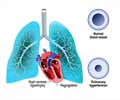
‘Analysis of over five million hospitalizations for acute heart failure has provided much needed insights for heart failure with preserved ejection fraction.’
Tweet it Now
"There is a need for studies that analyze HFpEF on a national scale, capable of reporting on the population's inherent heterogeneity using a broadly inclusive cohort, as such studies offer the promise of filling the gaps of knowledge that remain in the understanding of HFpEF, a disease process that still lacks proven therapies," explained lead investigator Parag Goyal, an advanced heart failure fellow in the Division of Cardiology in the Weill Department of Medicine at Weill Cornell Medicine and at NewYork-Presbyterian/Weill Cornell Medical Center, New York, NY. This study, conducted by researchers at Weill Cornell Medicine and NewYork-Presbyterian, represents the largest group to date of patients hospitalized with HFpEF. HFpEF is characterized by a "stiff ventricle" and patients typically have other medical conditions including hypertension, diabetes, lung disease, and/or chronic renal failure. Data were obtained from the Nationwide Inpatient Sample of all nonfederal U.S. hospitals through the Agency for Healthcare Research and Quality Healthcare Cost and Utilization Project for over five million hospitalized patients aged 18 and older from 2003-2012. Of the 5,046,879 hospitalizations for acute heart failure, 46% (2,329,391) of patients were diagnosed with HFpEF and 54% (2,717,488) had HFrEF. Patient and hospital characteristics, in-hospital mortality, and length of stay were examined.
There are several important findings in this nationally representative sample of U.S. hospital discharges examining HFpEF:
- HFpEF is, in fact, common among patients hospitalized with acute heart failure.
- Patients with HFpEF were most often women and elderly (75 years of age or older) who suffered from several other medical conditions.
- Over time, in-hospital mortality rates and length of stay for HFpEF improved in a subset of patients.
- Pulmonary hypertension was the strongest correlate for in-hospital mortality.
- Patients with other, treatable, disorders had a greater likelihood of in-hospital survival.
These data also revealed that HFpEF is potentially more severe in men, since men experienced higher rates of in-hospital mortality compared with women, and did not experience the decreases of in-hospital mortality that women experienced. Among individuals with HFpEF, blacks had lower in-hospital mortality rates compared with whites, a finding that may be related to the fact that blacks with HFpEF present at younger ages. "Whether these key differences stem from disproportionately inadequate treatment of hypertension in blacks or racial differences in left ventricular adaptive mechanisms warrants further investigation," commented Dr. Goyal.
Advertisement
Source-Eurekalert














